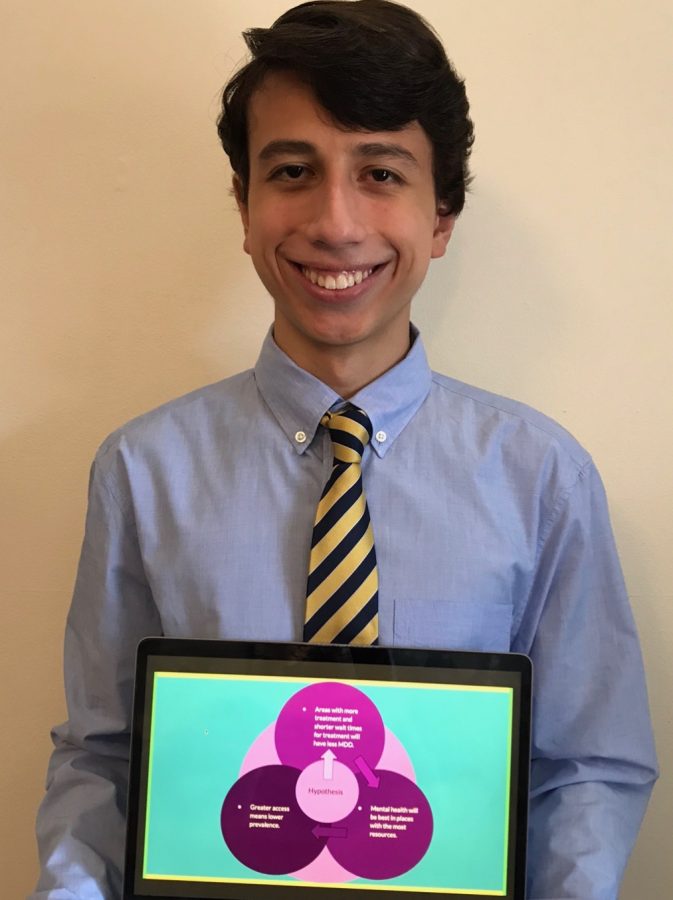OSR Students Pursue Projects in the Medical Field
In a world where medicine has become a top priority, these students have shown incredible dedication to medicine
Photo Courtesy of Jarvis Savage
Jarvis Savage and his OSR project on the relationship between MDD and access to treatment.
June 23, 2021
After months of weathering a global pandemic, the release of the COVID-19 vaccine was truly an indicator that things might be starting to turn around. One thing that most receivers of the vaccine acknowledge and appreciate, even months after its release, is that the vaccine is the product of several months of tireless work put in by unfaltering scientists. Out of a time of such distress and despair, at least one good thing has come – the renewed appreciation that not only Americans, but the human race now has for the invaluable field of health science. After all, it is hard to disregard a field whose work has recently influenced and will continue to affect the lives of millions across the world.
While this appreciation is new for many of us, Mamaroneck High School’s Original Science Research (OSR) program includes a handful of students with a passion for health science that predates the pandemic. Although the work they did in this field during their summer internships might not have dynamically altered the world the way the COVID-19 vaccine did, their findings and their feats are still deserving of celebration.
One such student is Alex Tan (‘21), whose main area of focus for his OSR project last summer was diet and its relationship to disease. More specifically, his study examined correlations between three different dietary indicators and a variety of cardiovascular illnesses, which are generally known for their association with diet and for being a leading cause of death in the US, on a countywide and statewide level. The first dietary indicator he looked at was food deserts, which are areas with a lack of food options. He also looked at food swamps, or areas with excessive amounts of unhealthy food options. Lastly, he looked at food insecurity rates, which are measurements of a population’s ease of access to healthy dietary options. His research was eventually able to confirm his hypothesis: the greatest correlation existed between food swamps and instances of cardiovascular disease across the country. His research further revealed that the correlative effects observed were much stronger on the statewide level than the countywide level. The findings of Tan’s research have huge implications for the dietary factors that local governments may choose to target.
Tan entered his project in the 2021 Westchester Science & Engineering Fair and won the third place prize for the Medicine and Health category. He reflects on his work and explains why it was so interesting to him, saying, “it allowed me to explore my interests while examining a problem which not only affected just my community, but the rest of the country as well.”
Jarvis Savage (‘22), who is also in the OSR program, has an area of interest that is also in the broad category of health science, but is quite different from Tan’s: mental health. Savage’s summer research project was on the topic of mental health treatment. He says that it was his interest in neuroscience, which he’s had “since as long as [he] can remember” that led him to the research he wound up doing in OSR on Major Depressive Disorder (also known as MDD or clinical depression). Savage comments that mental health is a topic he is interested in because he believes “it is an overlooked issue that is very prevalent and damaging to society [and that] more proactive steps need to be taken to address.”
This past summer, Savage completed a data analysis project investigating the question of whether access to treatment had any relationship to the prevalence of Major Depressive Disorder in a sample of British adults. Contrary to Savage’s hypothesis that increased access to treatment would correlate to decreased prevalence of depression, the results of his analysis actually showed the opposite: that increased treatment was associated with increased depression prevalence. The significance of these findings, in Savage’s words, is that they indicate that “more is needed than just a higher degree of treatment availability to reduce MDD.”
In the future, Savage looks forward to the OSR work he plans to complete this summer which will still be related to health science but will also incorporate more of a neuroscience perspective. Specifically, he plans to look at micro-RNA within the scope of opioid use disorder.
Both Tan’s and Savage’s projects are examples of innovative health science projects that have come out of the OSR program. Health science may be known for creating the vaccine, which will hopefully end the pandemic, but it is clear that Mamaroneck High School’s own students have been able to do their own noteworthy work within the field through the OSR program.







